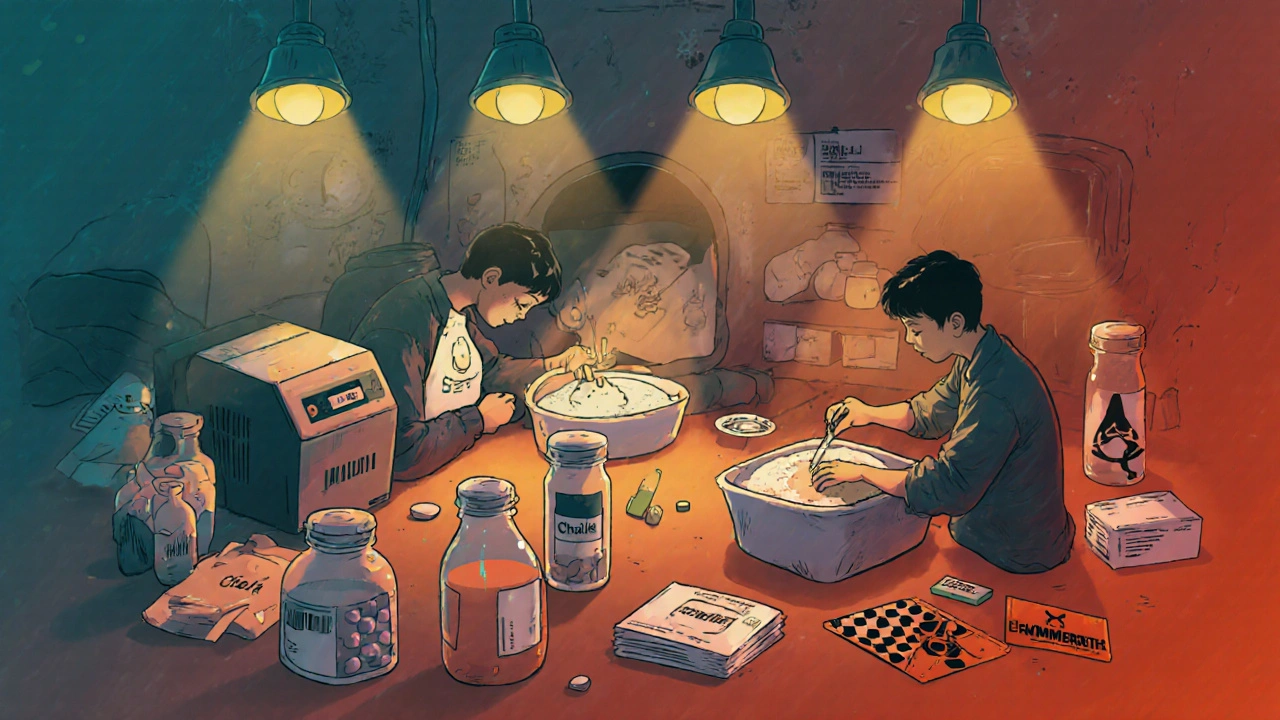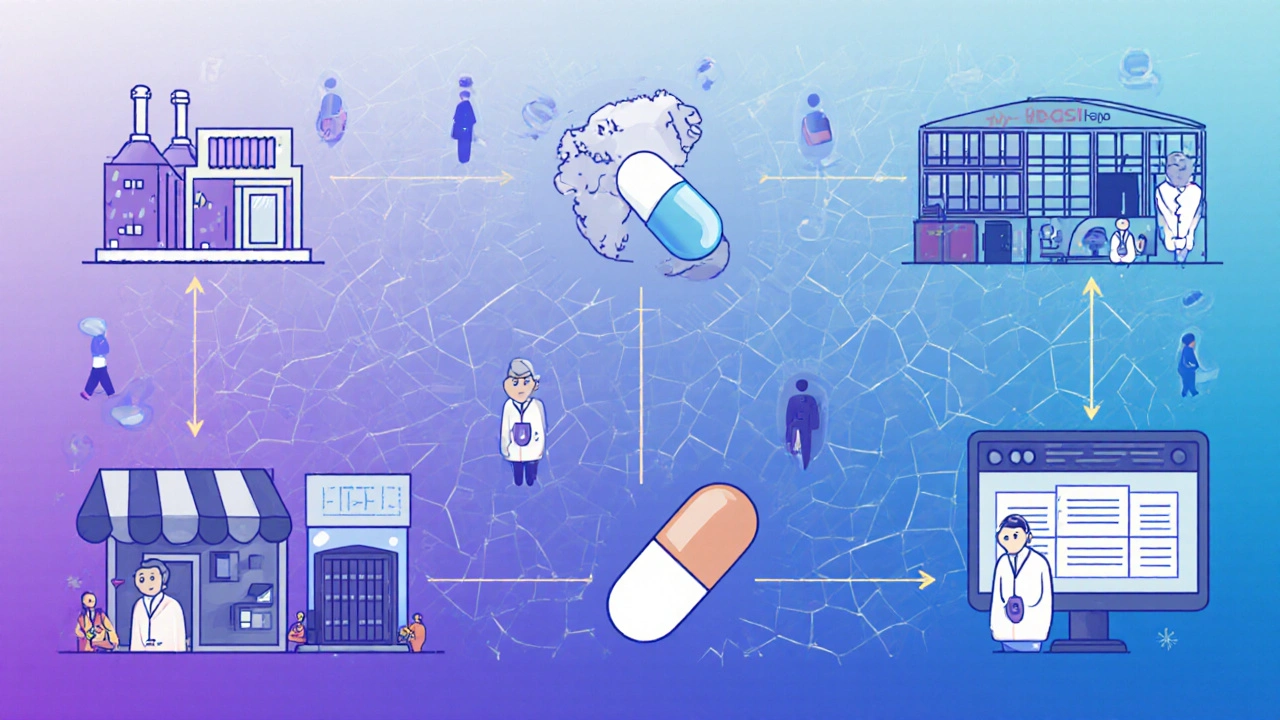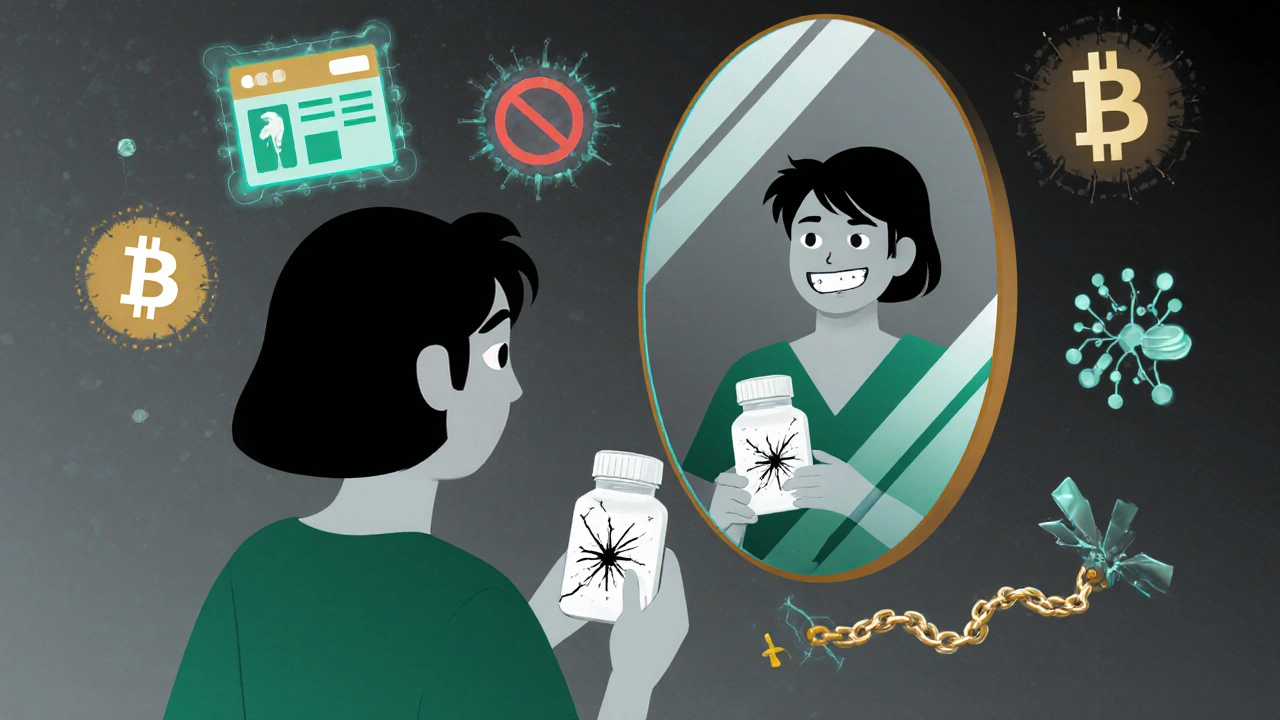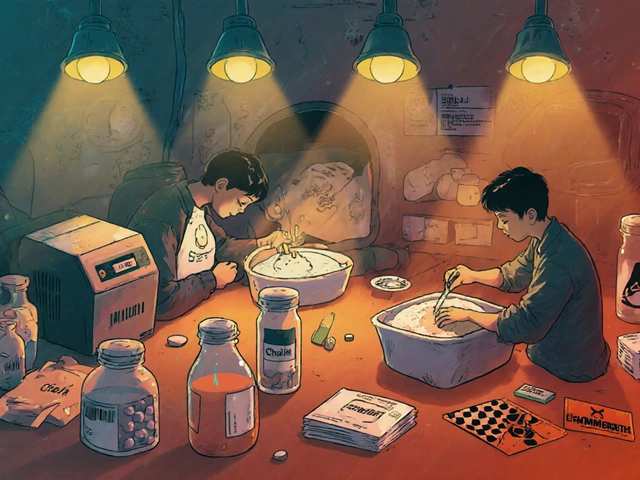Health and Medicine
Fake Generic Drugs: How Counterfeits Enter the Supply Chain

Every year, millions of people take generic drugs because they’re affordable, effective, and widely available. But what if the pill you swallowed wasn’t made in the factory you think it was? What if it had no active ingredient at all - or worse, something dangerous mixed in? This isn’t science fiction. It’s happening right now, and the fake generic drug problem is growing faster than most people realize.
How fake drugs are made
Counterfeit generic drugs aren’t just bad copies. They’re carefully crafted fakes. Criminals set up small, hidden labs - often in countries with weak oversight like parts of Southeast Asia, Eastern Europe, and West Africa. These aren’t high-tech factories. They’re basements, warehouses, even homes. But they’re good at one thing: mimicking real medicine. They start by buying cheap chemicals. Sometimes, they use the right active ingredient but in the wrong amount - say, only 10% of the needed dose for an antibiotic. Other times, they skip it entirely and replace it with chalk, talc, or even rat poison. The packaging? Often identical. High-resolution printers, real-looking foil seals, and even holograms are copied from genuine boxes. One 2023 analysis found that 95% of fake drug packaging looks indistinguishable from the real thing to the naked eye. The goal isn’t to cure anyone. It’s to make money. The global fake drug market is worth $200 billion a year, according to the OECD. For a pill that costs pennies to make, sellers can charge the same price as the real thing. And because generics are already cheap, the profit margin is huge.How they slip into the legal supply chain
You might think pharmacies and hospitals are safe. But counterfeit drugs don’t always come from shady websites. They often sneak in through the back door of the legal system. One major path is parallel importation. A drug approved in Germany might be cheaper than the same drug in the UK. Someone buys it legally in Germany, then resells it across borders - but not through authorized distributors. Along the way, fake pills get mixed in. No one checks. No one questions. Then there’s the grey market. This is where authorized distributors - the ones supposed to be trustworthy - start cutting corners. They buy bulk drugs from unknown suppliers to save money. They don’t test them. They just package and ship. In 2022, the National Association of Boards of Pharmacy found that 95% of online pharmacies operate illegally. But even some brick-and-mortar pharmacies unknowingly stock from these grey suppliers. The most dangerous route? Online pharmacies. A quick Google search for “cheap Lipitor” brings up dozens of sites. Most don’t require a prescription. Many don’t even have a physical address. You pay with crypto or a prepaid card. The pills arrive in a plain envelope. In 2023, a Reddit user reported receiving fake Lipitor with wrong tablet scoring and color - and when tested, it didn’t dissolve properly. That’s not just ineffective. It’s dangerous.Where the system breaks down
Why does this keep happening? Because the system isn’t built to catch fakes. Only 40% of countries have any kind of track-and-trace system for drugs. That means once a box leaves the manufacturer, no one knows where it’s been. No one knows if it was stored in a hot warehouse, swapped at a warehouse, or stolen and replaced. The U.S. passed the Drug Supply Chain Security Act in 2013, requiring full traceability by 2023. But only 22 of 194 WHO member states have fully working systems. Most don’t even try. Generic drugs are especially vulnerable. To make them, companies reverse-engineer the original. They don’t have to replicate the exact process - just the final product. That opens the door for corners to be cut. In 2018, a wave of recalls hit blood pressure meds because of cancer-causing impurities. Some of those came from poorly controlled manufacturing in India and China. That’s not always intentional fraud - but it’s just as deadly. And then there’s the human factor. Pharmacists are trained to dispense, not to detect fakes. A 2022 survey of 1,200 pharmacists across 45 countries found that 68% had seen suspected counterfeit drugs. But 32% said they couldn’t tell the difference. Training takes 8-12 hours. Most clinics don’t have the time or budget for it.
Real-world consequences
This isn’t theoretical. People are dying. In 2008, contaminated heparin - a blood thinner - killed 149 people in the U.S. The source? A Chinese supplier who mixed in a cheaper, toxic chemical. It passed every standard test because it looked like the real thing. In Africa, where 42% of all substandard and falsified medicines are found, antimalarial drugs are a major target. Doctors report patients getting sick again after treatment because the pills contained only 10-20% of the needed artemisinin. The malaria parasite doesn’t die. It mutates. And now, drug-resistant strains are spreading. In the U.S., the U.S. Pharmacopeia’s database shows over 1,200 confirmed cases of fake or substandard drugs between 2013 and 2023. The top targets? Cardiovascular drugs (28.7%), antibiotics (22.4%), and antimalarials (18.9%). These aren’t vitamins. These are life-saving medicines.What’s being done - and what’s not
Some progress is happening. The EU’s Falsified Medicines Directive, rolled out in 2019, forced pharmacies to scan barcodes on every pack before selling. Since then, counterfeit penetration in Europe has dropped by 18%. That’s real. Companies like Pfizer have spent nearly two decades fighting fakes. Their program has stopped over 302 million counterfeit doses since 2004. They work with customs, police, and distributors. But they’re fighting a war with one hand tied behind their back. New tech is emerging. DNA tags, chemical tracers, blockchain tracking - all promising. MediLedger’s blockchain pilot in 2022 detected supply chain anomalies with 97.3% accuracy. But these tools cost 2-5 cents per unit. For a $1 generic pill, that’s a huge markup. Most manufacturers in low-income countries can’t afford it. And then there’s AI. In early 2023, Europol seized cancer drugs with holograms generated by artificial intelligence. These weren’t just good fakes. They were better than the real thing - at least visually. The system couldn’t tell the difference.
What you can do
You can’t stop global crime. But you can protect yourself.- Buy from licensed pharmacies only. If it’s not on the official list of your country’s health regulator, don’t trust it. In the UK, check the GPhC website. In the U.S., use the NABP’s Verified Internet Pharmacy Practice Sites list.
- Check the packaging. Look for spelling errors, mismatched fonts, or seals that don’t match the real product. Compare it to photos online from the manufacturer.
- Don’t buy from social media or unknown websites. If it’s too good to be true - $5 for a 30-day supply of a $150 drug - it’s fake.
- Report suspicious drugs. If your pill looks wrong, tell your pharmacist. They’re required to report it.


stephen riyo
So you're telling me I've been swallowing chalk for my blood pressure meds? That's wild. I mean, I buy generics because I'm broke, not because I want to play Russian roulette with my heart.
Deirdre Wilson
I once got a bottle of ibuprofen that tasted like burnt plastic. Thought I was just weird, but now I get it. If it doesn't dissolve right or looks off? Toss it. Your body isn't a lab rat.
Gina Banh
Let’s be real: the FDA’s traceability system is a joke. They inspect 0.5% of imported generics. Meanwhile, Indian and Chinese manufacturers are turning out pills faster than McDonald’s turns out fries. The system isn’t broken-it was designed this way to keep drug prices low. Someone’s profit margin is your life expectancy.
And don’t get me started on parallel imports. You think your pharmacy in Ohio got that $3 lisinopril from a regulated source? Nah. It came through a distributor who got it from a broker who got it from a warehouse in Bulgaria that didn’t even check the batch number.
AI-generated holograms? That’s not sci-fi anymore. It’s Tuesday. The fakes are smarter than the inspectors. And the worst part? The people who need these drugs the most-low-income seniors, diabetics, HIV patients-are the ones getting the worst stuff.
It’s not about ‘buying from licensed pharmacies.’ That’s a Band-Aid on a hemorrhage. We need mandatory blockchain tracking for every pill, from factory to shelf. And we need it now. Not in 2030. Not when 7% of all meds are fake. Now.
Pharmacists aren’t trained to detect fakes? Fix that. Fund it. Make it mandatory. Pay them. This isn’t a supply chain issue. It’s a moral failure.
And stop acting like it’s ‘just generics.’ That’s the lie that gets people killed. A fake insulin pill doesn’t care if it’s branded or generic. It just kills you slower.
They’re not selling medicine. They’re selling hope. And hope doesn’t dissolve in water.
Bethany Buckley
One must interrogate the epistemological foundations of pharmaceutical trust in late-stage capitalism. The pill, as a semiotic object, has been commodified to such an extent that its ontological integrity is no longer guaranteed-only its aesthetic simulacrum remains. The hologram, the foil, the embossed logo-all are Derridean traces of authenticity, void of substance. We are not merely ingesting chemicals; we are consuming the ghost of medicine.
And yet, the neoliberal apparatus insists on ‘affordability’ as the sole metric of value, thereby incentivizing the production of pharmacological phantoms. The real tragedy? We’ve normalized this. We’ve made peace with the fact that our lives are contingent on the whims of a shadow supply chain.
Blockchain? AI? These are merely techno-solutions that defer the necessary structural reckoning: Who profits from our vulnerability? And why do we still believe in the myth of the ‘regulated market’?
Jaspreet Kaur
you know what really scares me not the fake pills but the fact that we just accept this as normal like its just part of life now when we used to trust our medicine like it was sacred now its just another product on the shelf no wonder people are sick all the time
Jesús Vásquez pino
Look, I get it. Cheap meds = survival. But here’s the thing: if your blood pressure med doesn’t dissolve in your mouth like it used to, you’re not imagining it. I had a cousin who took fake metformin for six months. He didn’t die-he just got worse. And no one caught it until his HbA1c hit 14.
Stop blaming the pharmacies. Blame the CEOs who cut corners to hit quarterly targets. Blame the regulators who sleepwalk through inspections. Blame the politicians who won’t fund enforcement because it’s not sexy.
This isn’t about ‘you’ buying online. It’s about the system being rigged. And we’re all paying the price.
Mqondisi Gumede
you americans always think you're the center of the world fake drugs are everywhere but you think only your country is affected? in africa we've been dealing with this since the 90s and you still act surprised like its a new problem
Albert Guasch
It is imperative to acknowledge the systemic vulnerabilities inherent within the global pharmaceutical distribution infrastructure. The absence of harmonized regulatory frameworks across sovereign jurisdictions has engendered a permissive environment wherein illicit actors may exploit jurisdictional arbitrage with impunity. The implementation of cryptographic traceability protocols, while capital-intensive, represents a non-negotiable imperative for the preservation of public health integrity.
Moreover, the conflation of cost-efficiency with efficacy constitutes a dangerous fallacy. The pharmacokinetic integrity of a therapeutic agent cannot be compromised without precipitating cascading physiological consequences, including but not limited to antimicrobial resistance, organ failure, and mortality.
It is therefore incumbent upon policymakers, industry stakeholders, and civil society to prioritize the institutionalization of universal, verifiable, and immutable supply-chain accountability mechanisms.
hannah mitchell
I’ve been buying my thyroid meds from the same pharmacy for 12 years. Never thought to check the batch number. Now I do. And I look at the pills. I feel like I’m paranoid. But after reading this… I’d rather be paranoid than dead.
Ginger Henderson
Okay but like… why are we even talking about this? I just want my $5 blood pressure pills. If I get a little chalk with my medicine, so what? I’m not dying. I’m just saving $120 a month.
Amanda Meyer
I’m not saying we should stop using generics. But we need to demand transparency. Not just from manufacturers, but from distributors, from pharmacies, from insurers. If your insurance only covers the cheapest option, and the cheapest option is the one with the highest risk of fakes… then the system is broken.
And yes, I’ve seen pills that looked wrong. I didn’t report it because I didn’t know how. That’s on the system. Not on me.
Damon Stangherlin
Hey, I’m not a doctor, but I’ve been managing my diabetes for 15 years. I’ve had bad batches. I’ve had pills that didn’t work. I thought it was me. Turns out, it wasn’t.
Don’t be afraid to ask your pharmacist: ‘Where did this come from?’ They’re not supposed to be mad. They’re supposed to help.
And if you’re buying online? Don’t. Seriously. Just don’t. I know it’s tempting. But it’s not worth it.
You’re not alone in this. We’re all just trying to stay alive.
Cynthia Boen
Oh wow. So the solution is to pay more? How revolutionary. I’m sure the people who can’t afford insulin will be thrilled to hear they need to pay $50 more for a pill that might still be fake. This article reads like a pharmaceutical industry PR piece disguised as journalism.